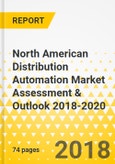The findings presented in this 74-page report are based on the completion of surveys received from 12 investor-owned utilities, 17 public power utilities, 21 electric cooperatives, and 3 electric utilities in Canada. This utility sample represents electric power service to more than 16 million customers in the US and Canada, amounting to about a 10% sample based on North American customer totals.
About one-half of the utilities in the survey sample consisted of companies providing electricity to at least 100,000 users. A listing of all participating utilities is included at the end of this report. Several of the largest public power and electrical cooperatives participated in this year’s survey.
Table of Contents
- Introduction
- Outlook Section for North American Distribution Automation: Trends in DA Investment for 2018-2024
- Survey Findings
- Please indicate the approximate number of distribution feeders (4kv-38kv) on your system.
- Approximately what percentage of all your feeders have SCADA controlled sectionalizing switches installed with an operation that is A) manual B) semi-automatic or C) fully automatic?
- Approximately what percentage of all your feeders have or will have Fault Detection Isolation Restoration (FDIR) or Fault Location Isolation Service Restoration (FLISR)?
- Approximately what percentage of all your feeders have or will have Volt Var control (VVC), Volt-Var Optimization (VVO), or Conservation Voltage Reduction (CVR)?
- What is driving your decision for VVO? Check all that apply.
- Where is the logic located for FDIR/FLISR on your distribution system?
- In the future, where do you anticipate the logic to be located for FDIR/FLISR?
- Where is the logic located for Volt/Var control on your distribution system?
- In the future, where do you anticipate the logic to be located for Volt/Var control?
- Does your utility use automatic fault sensing (AFS) devices (hotline status, fault indicators) in your feeder design?
- If you do use automatic fault sensing, do you utilize the status of the communicating automatic fault sensing devices in your distribution automation applications?
- Have you integrated any communication/controls for distributed generation (DG) into your DA system architecture?
- Are you considering a trial deployment to manage distributed energy resources - DER - (e.g. inverters, energy storage, EV chargers, etc.) within the DA system?
- Does your utility integrate sensing and/or Volt/Var control at the LV side of the distribution transformer within the DA system?
- Does your utility plan to use sensing and/or Volt/Var control at the LV side of the distribution transformer to support any of the following applications?
- What other DA applications use the same telecommunications infrastructure being used by feeder automation?
- How are you notified of a feeder main fault event? (Check all that apply)
- Does your utility run distributed software applications (like S&C Intelliteam II, L+G Grid Stream; SCADA center product suite, Cooper/Yukon Feeder Automation, G&W/Survalent Lazer Automation)
- Do you use a centralized (control center based) tool for communication network management and security management?
- Please check any of the following functions you would like to have integrated into a communications/security management tool for MV Feeder Device management (like recloser controller, capacitor bank controllers, remote controlled switch).
- Do you currently use (or plan to use) encryption on your communications network for distribution automation?
- Do you plan to upgrade the existing Feeder Automation network to a newer, wireless technology that allows for features like higher bandwidth, IP enabled radios (i.e. 4G, LTE or WIMAX) by the end of 2020?
- If you do plan on upgrading your Feeder Automaton network, which wireless technology do you plan to use?
- In your best estimate, what is your total budget for DA projects for the years 2018-2020?
- If possible, please approximate the percentage (%) of that DA budget that applies to FDIR, Integrated VVC, and MV/LV Sensors
- For 2018-2020, please estimate what percentages of your total DA expenditures will be allocated among the three categories listed below
- Do you currently use/plan to use bi-directional regulators on your system?
- Do you currently use/plan to use bi-directional reclosers on your system?
- Do you currently use/plan to use dynamic protection (real time modification of protection settings) on your system?
- Utilities Participating in the Study
Samples

LOADING...
Companies Mentioned
Companies who participated in this survey:
- Austin Energy
- Avista Utilities
- BGE
- Carroll EMC
- Cass County Electric Coop
- City of Ames - Electric Services
- City of Medicine Hat
- City of Riverside
- Clark Public Utilities
- Cleveland Utilities
- Clinton Utilities Board
- Cobb EMC
- Commonwealth Edison Company
- Consumers Energy
- Cowlitz PUD
- Dakota Electric Association
- Duke Energy Progress
- Energy United
- Fort Collins utilities
- Greystone Power Corp
- Hagerstown Light Department
- Huntsville Utilities
- Hydro-Sherbrooke
- Indianapolis Power and Light
- Lafayette Utilities System
- Liberty Utilities Central
- Memphis Light, Gas and Water Division
- Mid-Carolina Electric Cooperative, Inc
- Middle Tennessee EMC
- Midwest Energy Inc
- Nashville Electric Service
- NOVEC
- Omaha Public Power District
- Orange and Rockland Utilities
- Ozarks Electric Cooperative
- Pickwick Electric Cooperative
- Portland General Electric
- Rappahannock Electric Cooperative
- Roseville Electric
- Rutherford EMC
- Saint John Energy
- Salem Electric Dept.
- Silicon Valley Power
- Sioux Valley Energy
- SMECO
- Snohomish County PUD
- South Ky RECC
- United Power, Inc.
- Unitil
- Upper Cumberland Electric Membership Corp
- Verendrye Electric Cooperative
- Withlacoochee River Electric Cooperative, Inc.
- Xcel Energy








